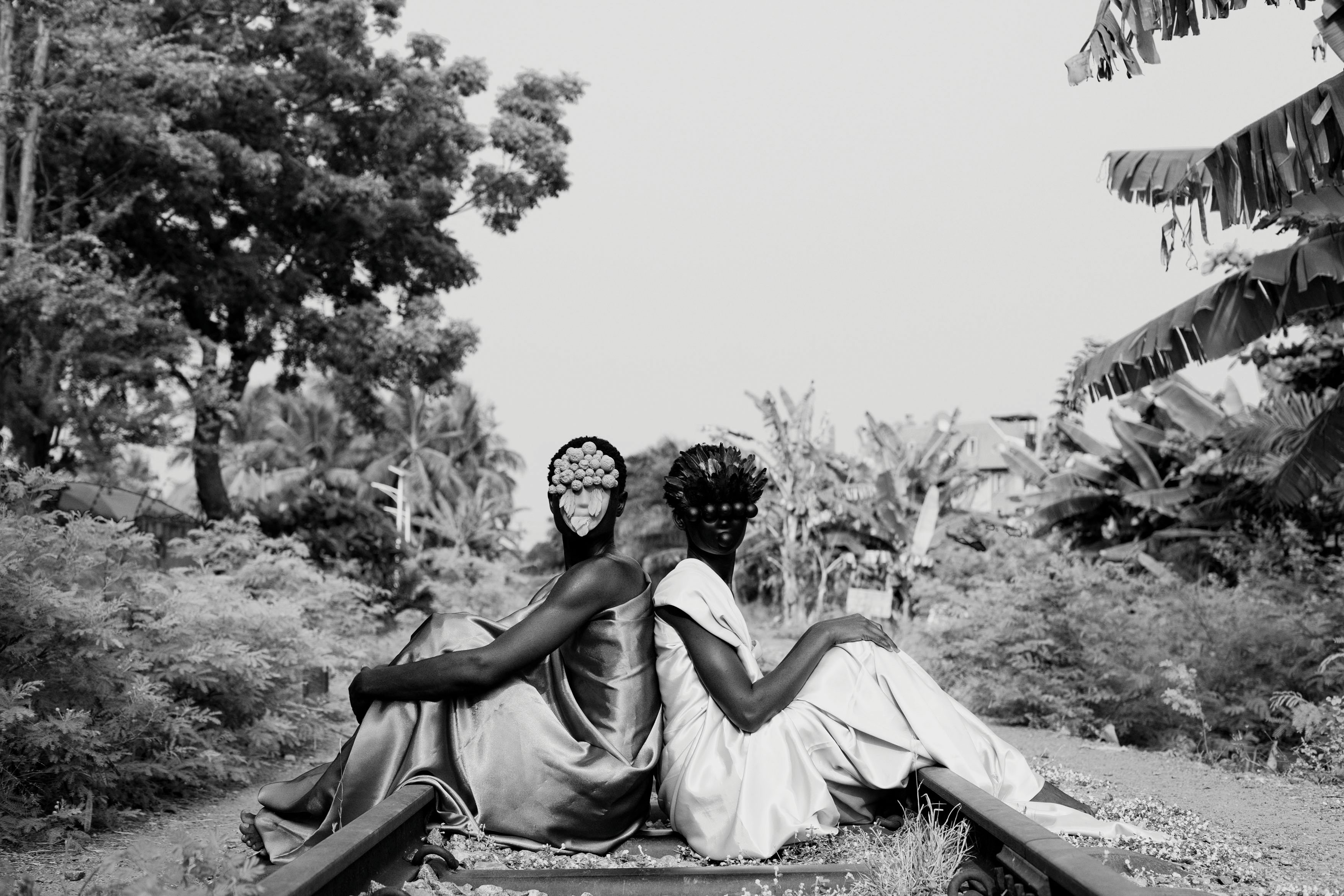
Strauss & Co.’s Curatorial Voices auction in February
Latitudes is proud to be a curatorial voice on the upcoming Strauss & Co. Auction: Curatorial Voices: African Landscapes, Past and Present.
Spanning 175 years of visual landscape painting on the African continent, the sale promises to be an extraordinary convergence of work celebrating pioneering modernists and trailblazing contemporary artists.
Latitudes' Head of Sales, Camilla van Hoogstraten, has curated a section of the auction, which proudly presents works by seventeen Pan-African artists. The selection includes never-before-seen pieces from artists' studios and the collaboration aims to build auction records for living artists from the African continent and diaspora.
Auction opens 5 February 2024
Live virtual auction 19 February 2024
If you are in Cape Town be sure to visit Strauss & Co’s newly renovated space in Woodstock up until the 19 February 2024
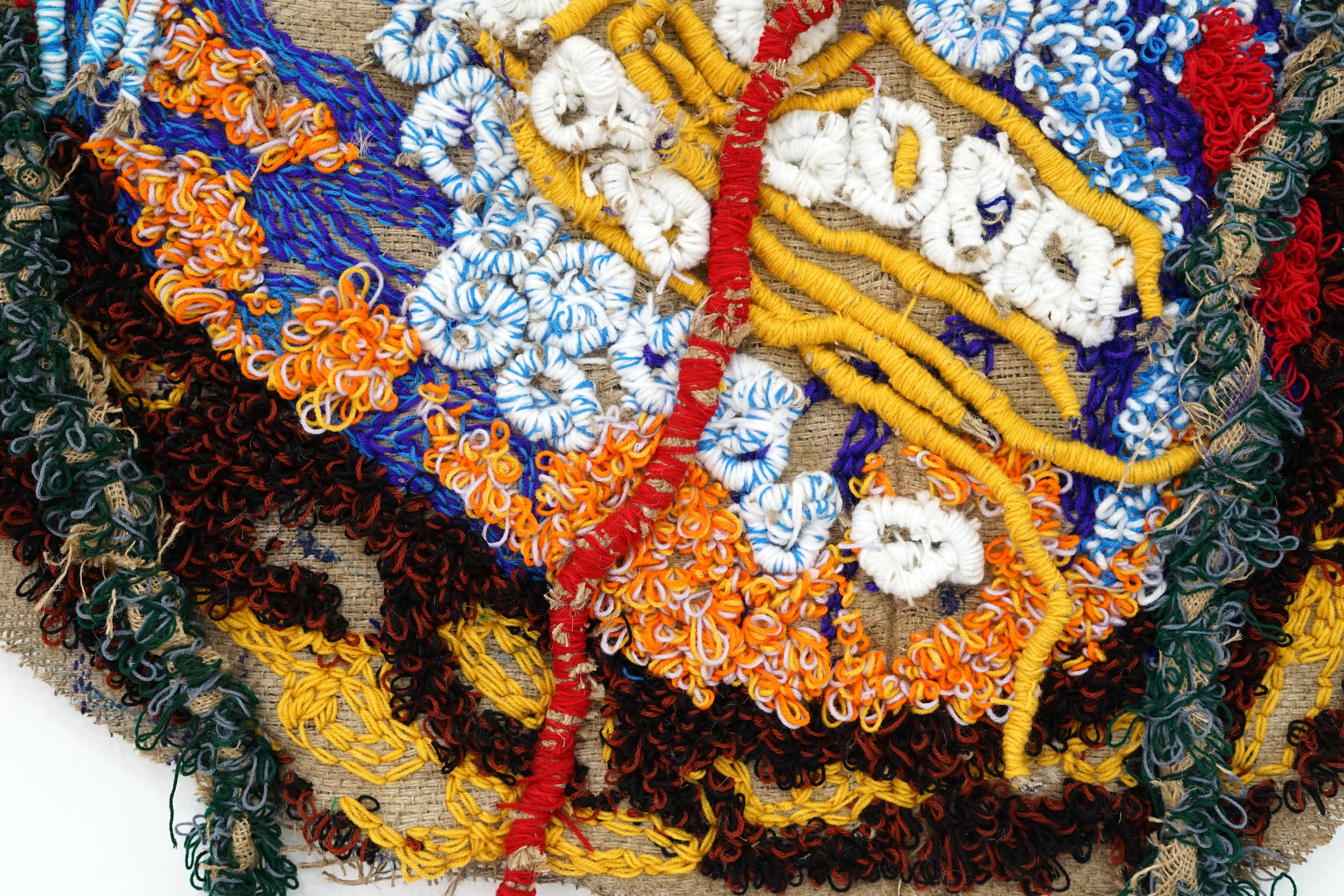
Meet the Artists
This presentation acknowledges land dispossession as the foundation of the economic and social inequality that pervades Africa today. It also seeks to draw attention to the fact that the dispossession of land had profound impacts on the preservation of African communities, rituals, traditions, ancestral ties, food and water stability and trade routes, amongst other aspects of African life. It posits that many contemporary issues can be traced back to colonialism by considering a pre-colonial Africa wherein most indigenous African communities regarded themselves as an extension of the land. Their approach was one of symbiosis, to nurture and respect the land. Thus, the body and nature could not be separated. This meant that the land was inextricable from the social, spiritual and environmental practices of its communities. By contrast, the artworks also explore the way in which colonisers viewed land, people, and resources through a lens of domination and control.
Today, society still speaks of ‘property’ as opposed to ‘land’, recognising it first and foremost as a commodity. The shift in language is reflective of society’s current disconnection with land and each other, as we reduce our understanding of land, and dispossession, to something purely economic in nature. The artworks presented explore the aforementioned disconnect, posing contemporary Pan-African responses to land, challenging ideas around colonial borders, restitution, and our relative relationships with the land - socially, spiritually, economically and environmentally - with a focus on indigenous knowledge and systems.
— Camilla van Hoogstraten, Head of Sales
Dive into the artists' practices
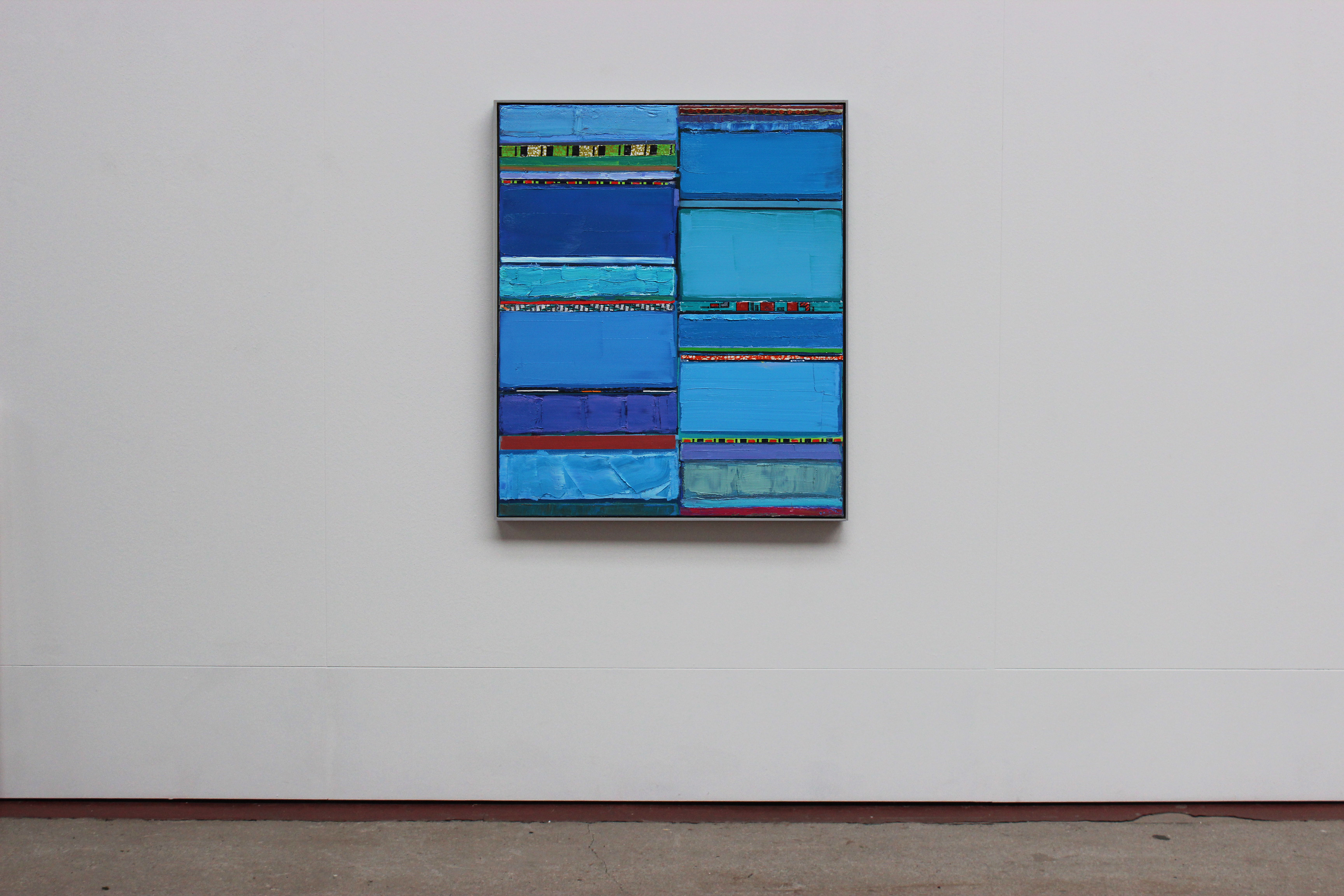
Untitled, 2023, Oil and textile on canvas, 124 x 103 cm
Tegene Kunbi (Ethiopia)
Working from small to large scale, Kunbi’s works have developed into a distinct signature use of colour blocking and mixing, heavy textured use of oil, mixed with bright colorful patterned textiles that refer to his home country, Ethiopia. With a defined interest in landscape and the dialectic power of colour and form, Kunbi’s practice is a contraction of push and pull between the materiality of the works and his subject matter. Referencing the land and cultural signifiers of his home country, he searches for harmony between all the elements at play. He layers texture upon texture, and colour upon colour as he looks for the character within each work. It is the challenge of everyday that defines the possible future outcomes of each work which is an amalgamation of time he spends with each piece. The result are maps of places, people, and lived histories.
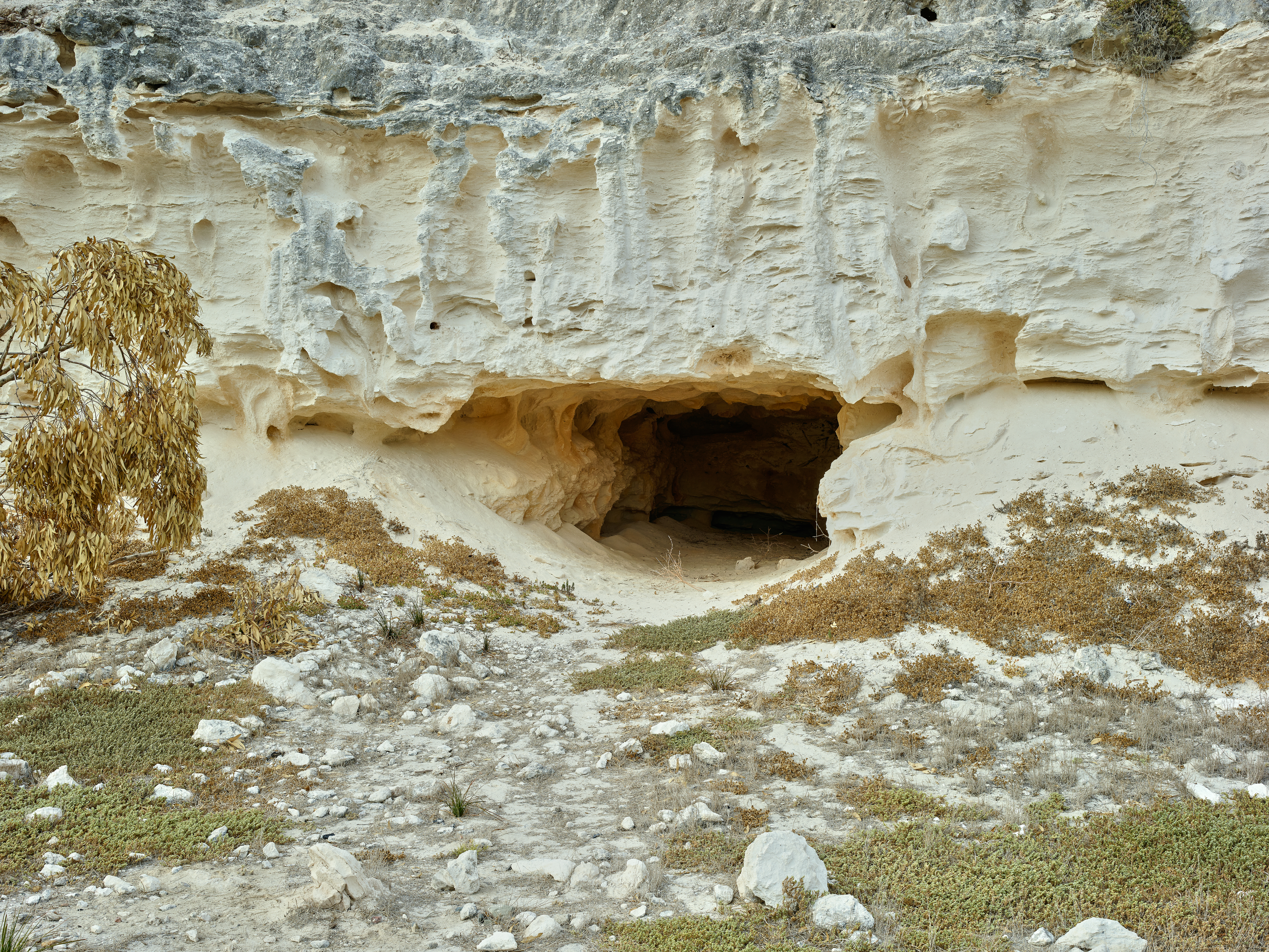
Robben Island University, 2020, Digital photography printed on Hahnemühle Photo Rag Baryta, 89.1 x 118.9 cm, Edition of 1/7
Thero Makepe (Botswana)
Thero Makepe uses personal and public archives to explore the minds of different family members during crises, separation, and ennui with an exquisite empathy behind the lens. Makepe is a descendent of jazz legend, John Mothopeng, and of Zephania Mothopeng, the second president of the Pan-Africanist Congress of Azania (PAC) during the armed struggle against apartheid. In We Didn’t Choose to be Born Here, Makepe traces his family history, exploring everything from their activism and exile during (and after) apartheid to their inherited love of jazz. We Didn’t Choose to be Born Here relays a family’s holistic and individual experiences of and with resistance, beauty, struggle, love, heartbreak, discovery, and rediscovery. It is formed by identities lost and found, forged in mettle. Each portrait a brief, delicate portal into an individual’s innermost world. Each landscape a testament to enduring strength, love and sacrifice. Thero Makepe's Robben Island University (2020) speaks to his own family's experiences in the prison; Robben Island’s limestone quarry was a gathering and learning space for inmates who wished to share their respective knowledge and skills with one another. The limestone quarry is recognised as a crucial part of our nation's history, largely owing to its facilitation of the transfer of vital information in a time where education was denied to and/or restricted for Black people and people Of Colour by the apartheid government. Today, the very place that enabled this transfer of information now represents invaluable inter-generational knowledge in and of itself.
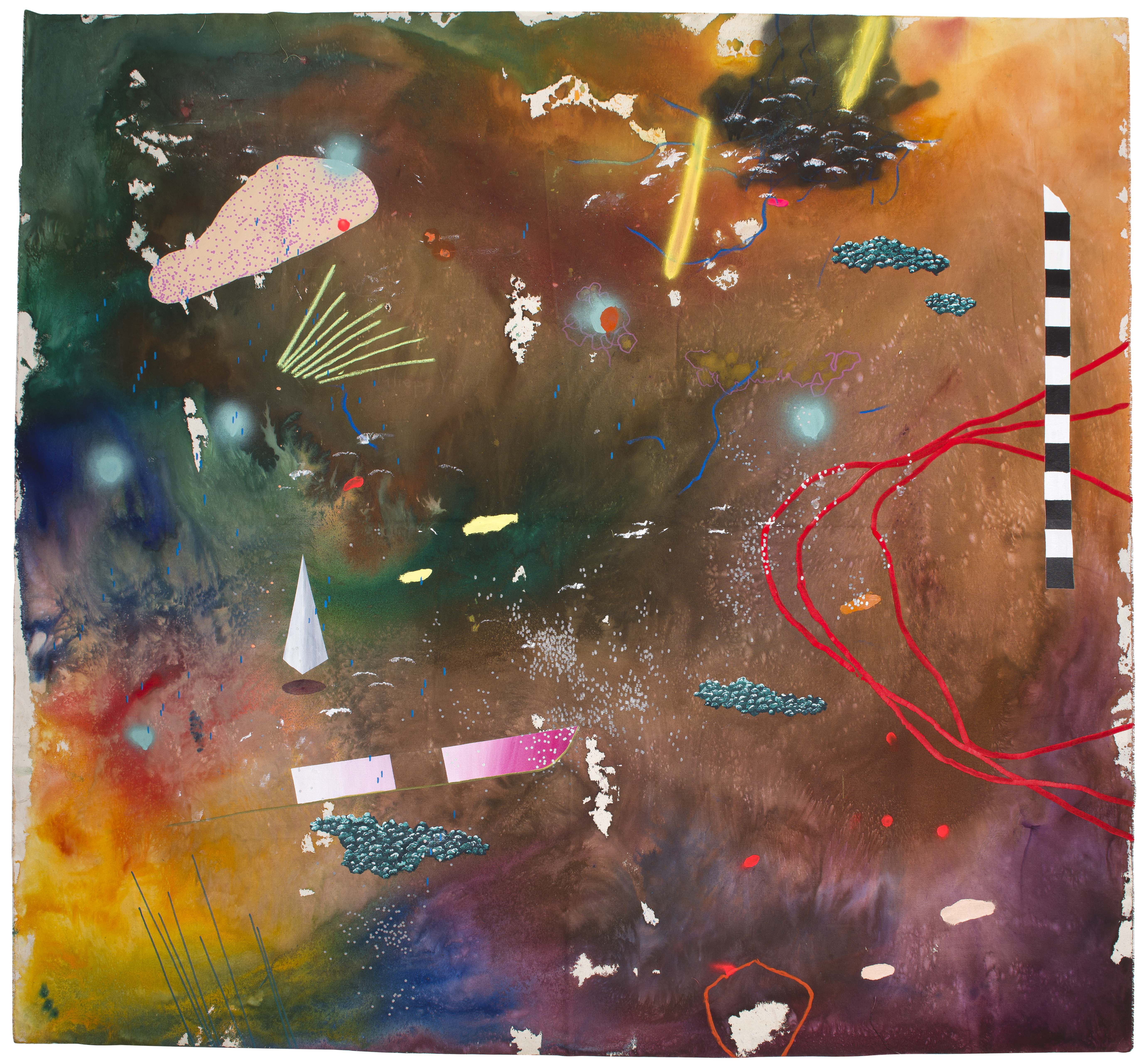
Taleip, Yay!!!, 2024, Mixed media on canvas, 175.5 x 183 cm (unstretched)
Mongezi Ncaphayi (South Africa)
For Ncaphayi, who exists in liminal spaces, exploring the grey matter in life, abstract art provided him with an outlet through which he could channel and express his innermost thoughts and feelings, turning to colour and composition. Taliep, Yay!!! is a particularly personal piece for the artist, dedicated to Ncaphayi’s dear friend in the Bo-Kaap in Cape Town. The Bo-Kaap neighborhood was built in the 1760s by Jan de Waal, a Dutch colonialist; de Waal developed rows of small rental houses to provide accommodation for the city’s Cape Malay slaves. Today, the residents of the Bo-Kaap who have inhabited the area for generations, face threats of losing their homes, culture and community again as a result of exponential rate hikes and a municipal government who favours commercialisation over the preservation of culture, tradition and history. This is the perfect example wherein land becomes property and profits over people and the planet prevails. Ncaphayi’s piece is a testament to the range of emotions that he associates with the Bo-Kaap and Taliep – bold, colourful, deeply complex and resilient.
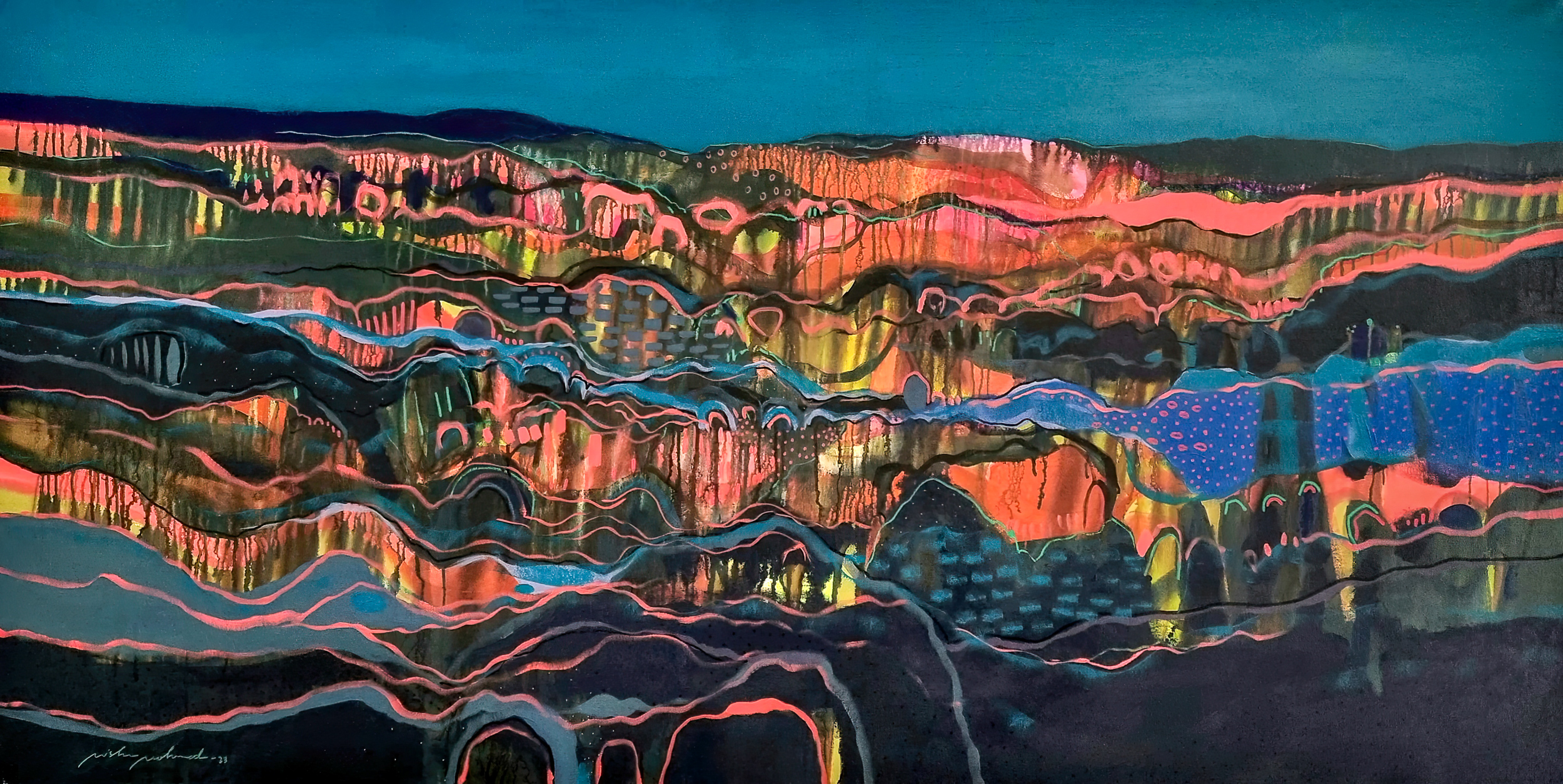
Autumn forests, 2023, Acrylic & markers on canvas, 90 x 180 cm
Miska Mohammed (Sudan)
Miska was born in 1995, in Omdurman, Sudan. Miska Mohmmed works predominantly in oils and acrylics combining material experimentation with an exploration of the sensual experience of landscape.
Miska trained as a painter for a long time, practiced painting “en plein air” guided by her experience of nature, atmosphere, and the movement and bustle of crowded spaces.
Miska renders landscape which remains the focus of her painting practice as a semi-abstract series of sweeping horizontal lines whose direction, colour, and varying density approximate the terrains from which they are drawn. Mohmmed received in 2016 a BFA in Painting from the College of Fine and Applied Arts, Sudan University. Mohmmed has exhibited widely in Sudan, Kenya, Nigeria, Egypt, Dubai, Tunisia, New York, UK, Germany and Zanzibar.
She participated at Art Dubai 2022, Dubai, UAE; Art X Lagos 2021 and 2019, Lagos, Nigeria; FNB Art Joburg, Johannesburg and Investec Cape Town Art Fair 2021, Cape Town, South Africa; the Rashid Diab Arts Centre in Khartoum, Sudan; and the French Cultural Centre in Khartoum, Sudan among others.
Art Collectors Carla and Pieter Schulting exhibit her artwork from September 2023 to April 2024 at Kunsthal Kade, Amersfoort, the Netherlands, for Africa Supernova, a group show with a selection of 100 artworks of their collection.
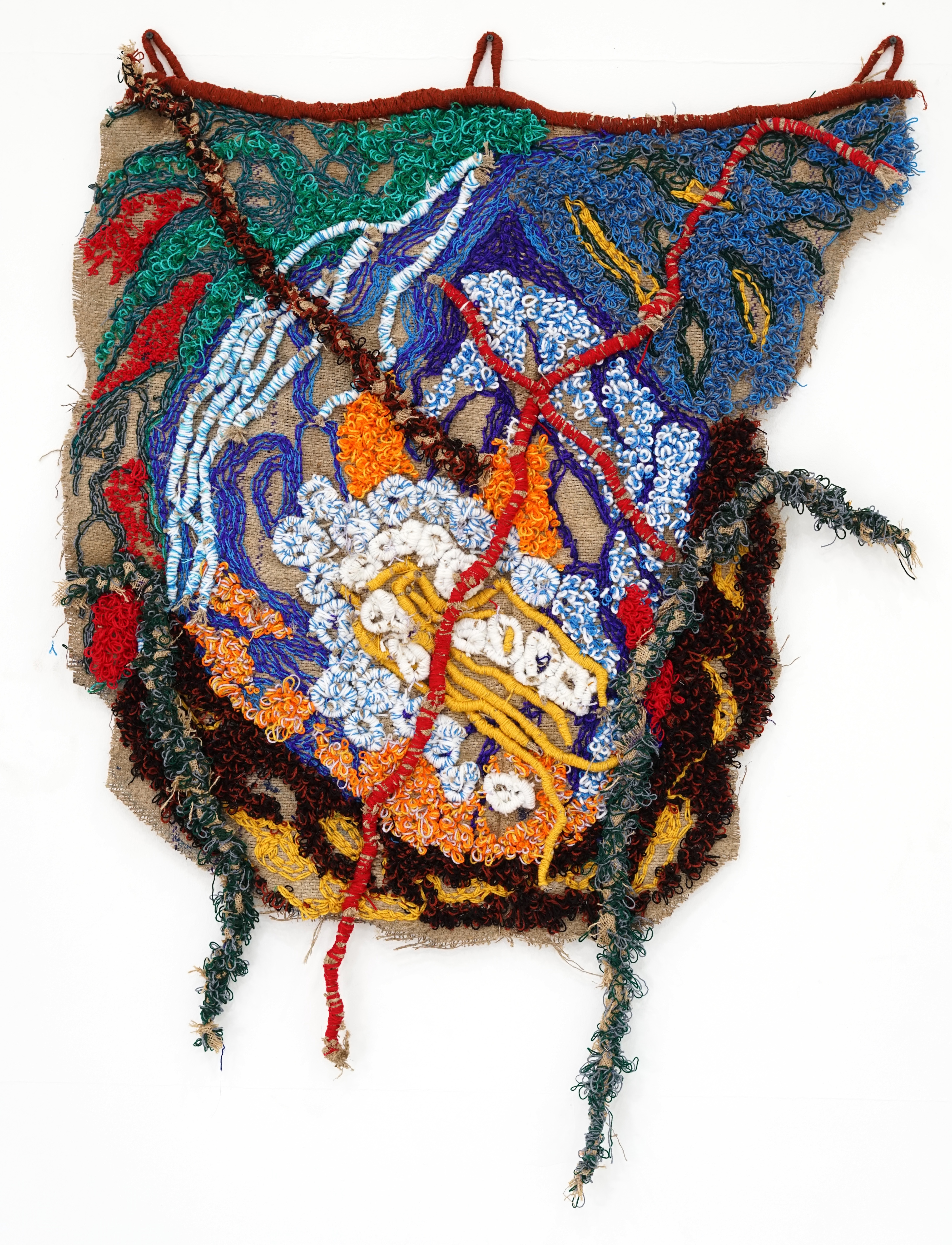
Web of Life 8, 2023, Jute and cotton thread, 135 x 98 cm
Fiker Solomon (Ethiopia)
Fiker Solomon is an Ethiopian artist living and working in Addis Ababa. She graduated from Ale School of Fine Art and Design, Addis Ababa University with a major in Fashion Design in 2014. Since graduating from art school, she has been developing a unique style incorporating exclusively natural materials like jute, cotton, sisal and others into intricately intertwined tapestries. While she stitches, punches and knots the different materials together, she is continuously experimenting with new techniques to manipulate and join the material.
The artist’s work is inspired by the natural world around and within us. Growing up, many of us revel in the simple joys of the sun, mud, winter, and the entirety of nature. Reflecting on those times now, amidst the chaos of life's complexities, where competition, disappointment, sorrow, and joy coexist, we realize that these emotions are as seasonal as our natural surroundings. Fiker’s work is a reflection on this cyclical nature of our feelings and needs, mirroring the changing seasons. It serves as a means to liberate our minds from the intricacies of life.
Recognizing our indispensable role and connection to the natural world, working with 100% natural and biodegradable materials is not just an appreciation and paying respect to the latter, but also motivated by the versatility of its inherent properties. This journey began with an observation from her surroundings: Jute sacks – both biodegradable and eco-friendly, absorbing carbon dioxide and releasing oxygen even more rapidly than trees and, in Ethiopia, primarily used for coffee export. The jute employed in the artist’s work are those typically deemed useless after it having aged or being torn.
The creative process of working with textiles holds significant meaning for the artist, as it is a skill she initially learned from her mother who would craft diverse decorative embroideries for the sofa, table, and the children. She later added her personal twist to the rather traditional skill, and conceptually took it beyond the decorative and functional realm.
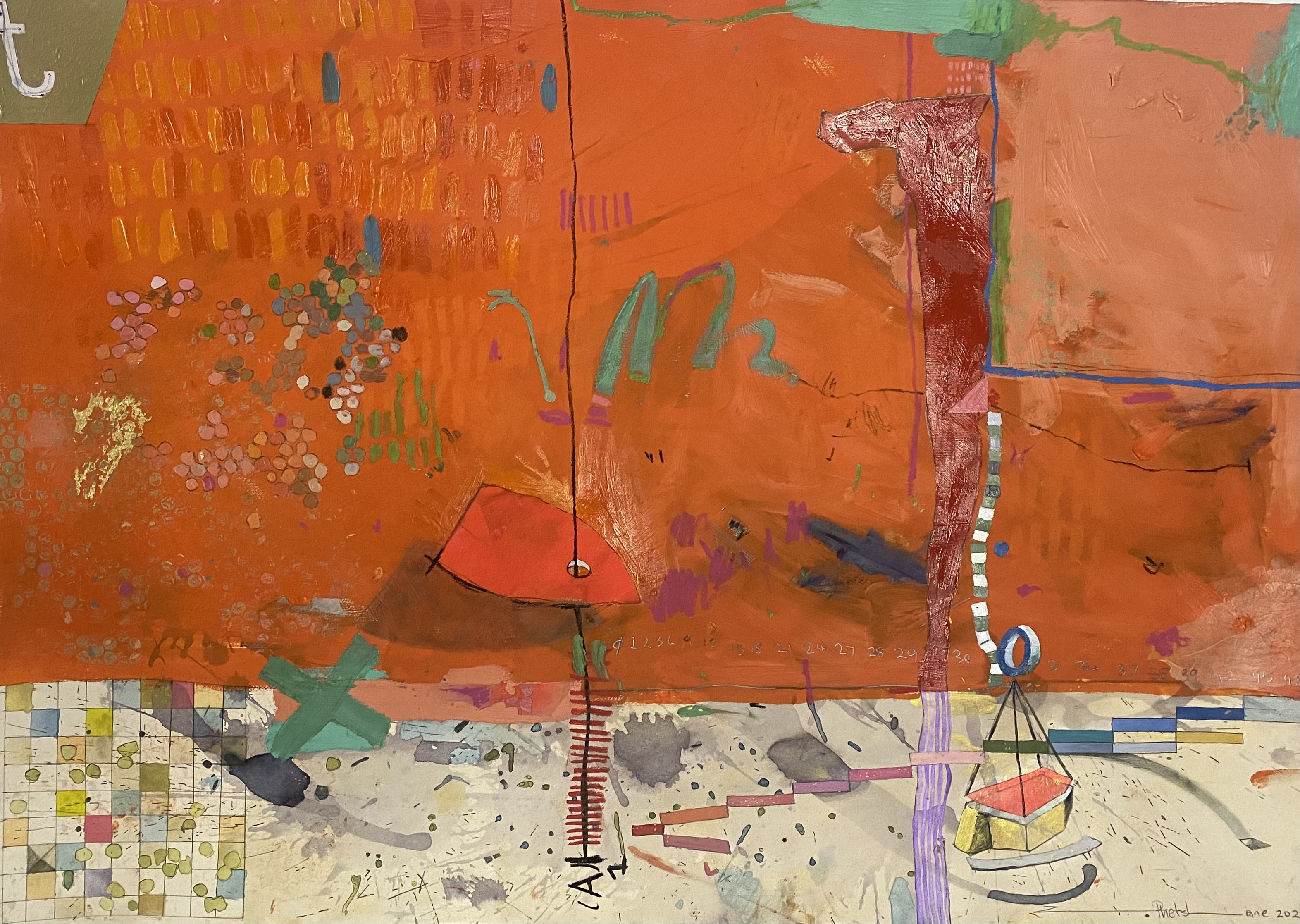
Stories told in Colour, 2023, Mixed media: oil paint on Fabriano, 70 x 100 cm
Zolile Petshane (South Africa)
Throughout his career, Petshane has explored contemporary topics such as religion, politics, consumerism and capitalism. He explores the intricacies of these themes through a combination of abstract colour fields, figurative elements and symbols, as well as collage. He works in a variety of media ranging from printmaking, pastel and oil pastel on paper, acrylic and oil on canvas.

Ecosystems of Healing No. 16, 2021, Photo exposure on Fuji paper, 40x60 cm, STD 1/5
Samira Saidi (Ghana)
Ecosystems of Healing is a photo series depicting the importance of mental health in the Global South, focusing on West Africa. The common understanding of trauma and mental wellbeing has been shaped by the experience of the West and often forms a bubble of misunderstanding towards different approaches. In African communities, family, nature, and spirituality mould the foundation of mental wellbeing. Throughout its colonial past and exploitative present this perspective towards mental health has been alienated and has resulted in the act of turning into oneself in the search of oneness. This series explores the different understandings of what it means to be mentally well in a system that has been constructed from a Western point of view.
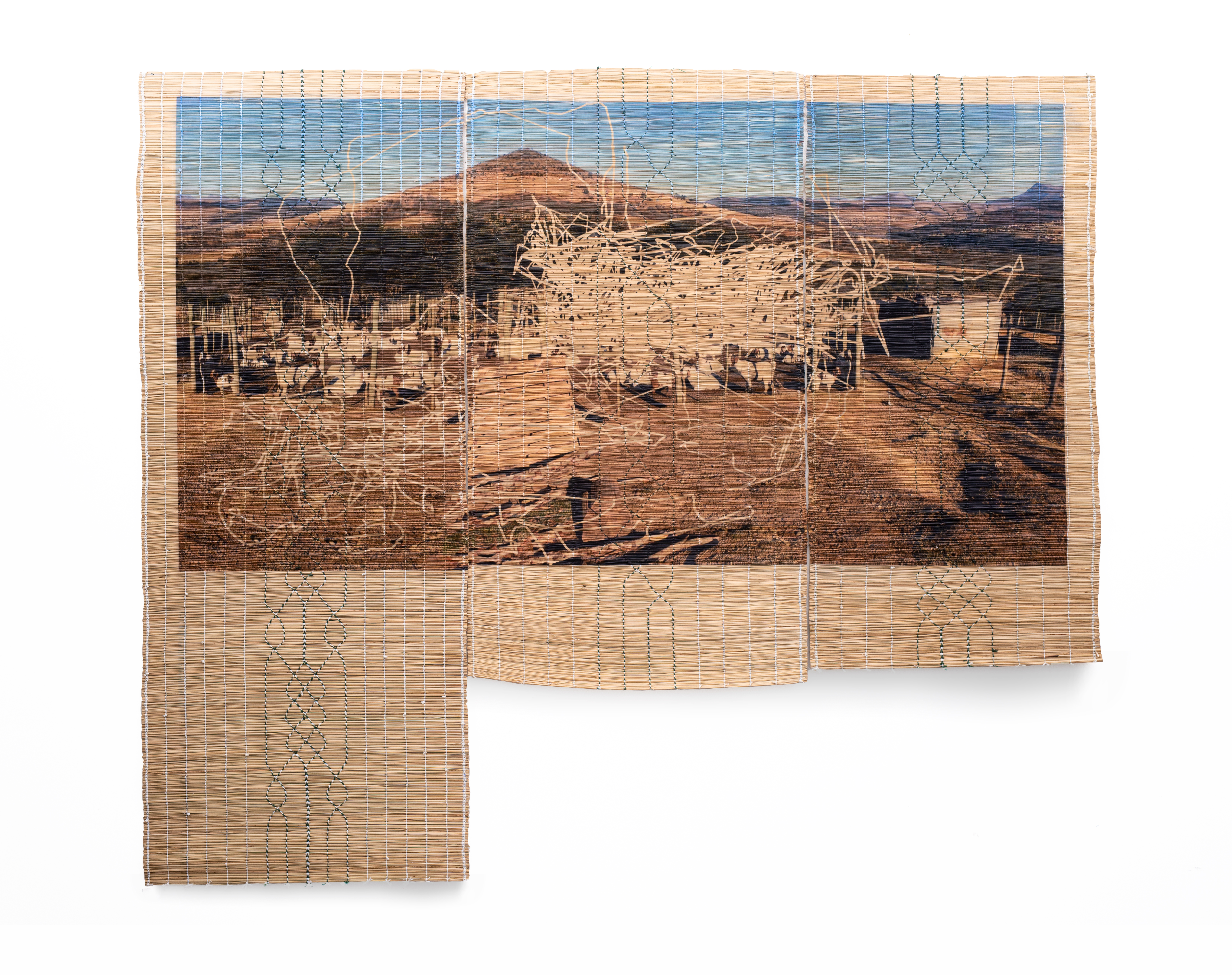
Nkqo Nkqo Nkqo eChumakala, 2022, Inkjet print and gouache on ikhukho, 204 x 240 cm
Xhanti Zwelendaba and Benjamin Stanwix (South Africa)
The images on the mat works are constructions that combine photographs Zwelendaba and Stanwix have taken with found images from different sources - archival and online. This three-panel work, ‘Nkqo-nkqo-nkqo eChumalaka’ (knock-knock-knock in Chumalaka), presents an Eastern Cape setting with a small goat pen in the foreground and a village on the nearby hill. The dominant colours are earthy browns, muted dark green shrubs, grass, and a blue sky. The scene depicts a familiar and ongoing form of human engagement with land in South Africa, a mix of community life and limited commercial intervention. A series of busy lines criss-cross and break up the picture. These are made from digital records of the artists’ movements while planning the work – a combination of walking, driving, and working in the studio. Conceptually they are connected to the traces people make as one walks or moves through a landscape, but they are also linked to the history of marking out new territory using dividing lines, markers, and maps, which serve as a kind of invention of reality – like the image that Zwelendaba and Stanwix have pieced together here.
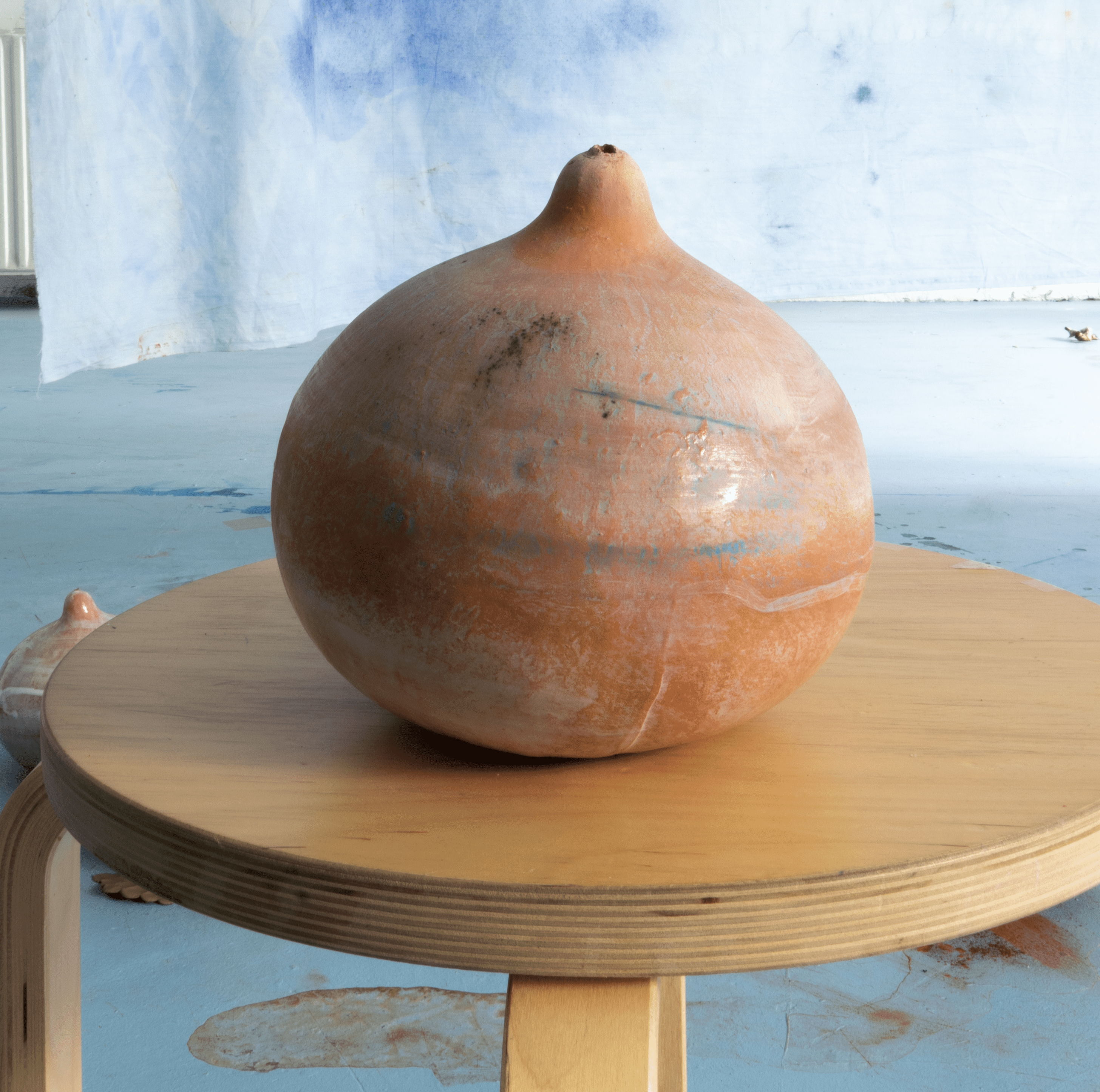
Ngomi ii, 2023, Ceramic with custom-made glazes, 25 cm (55cm in diameter)
Agnes Waruguru (Kenya)
Waruguru’s Ngomi series was created during her residency at Rijksakademie. The artist developed a glaze medium with pigment that allowed her to glaze the calabashes as if they were paintings or drawings. The artist has long reckoned with her own personal history, particularly in relation to Kenya and living the diaspora. Waruguru regards the calabashes as little grief capsules. When held up to the ear, they sound like a seashell and create an echo chamber where the environment around one is distorted.

God save our hedge 1 (Botanical Imperalism Series), 2015, Photographic Print, Edition 1/5, 80 x 120 cm
Thania Petersen (South Africa)
’A stubborn remnant of the past, Jan van Riebeeck’s almond hedges are the subject of the 2015 photograph God save our hedge 1 (Botanical Imperialism Series). The image is an apt companion to Queen Colonaaiers and her weapons of mass destruction 1 of the same year. Surrounded by colonial foliage, Petersen appears at odds with her contexts. This power relation is swiftly turned around in the 2017 collage Bahasagalaramashari, in which Petersen, and who could be assumed to be her family, appear in harmony with their environment. Devised by Petersen herself Bahasagalaramashari is a Utopic concept, and provides a sense of hopefulness and power within the exhibition.’ (Amie Soudien, 2017)
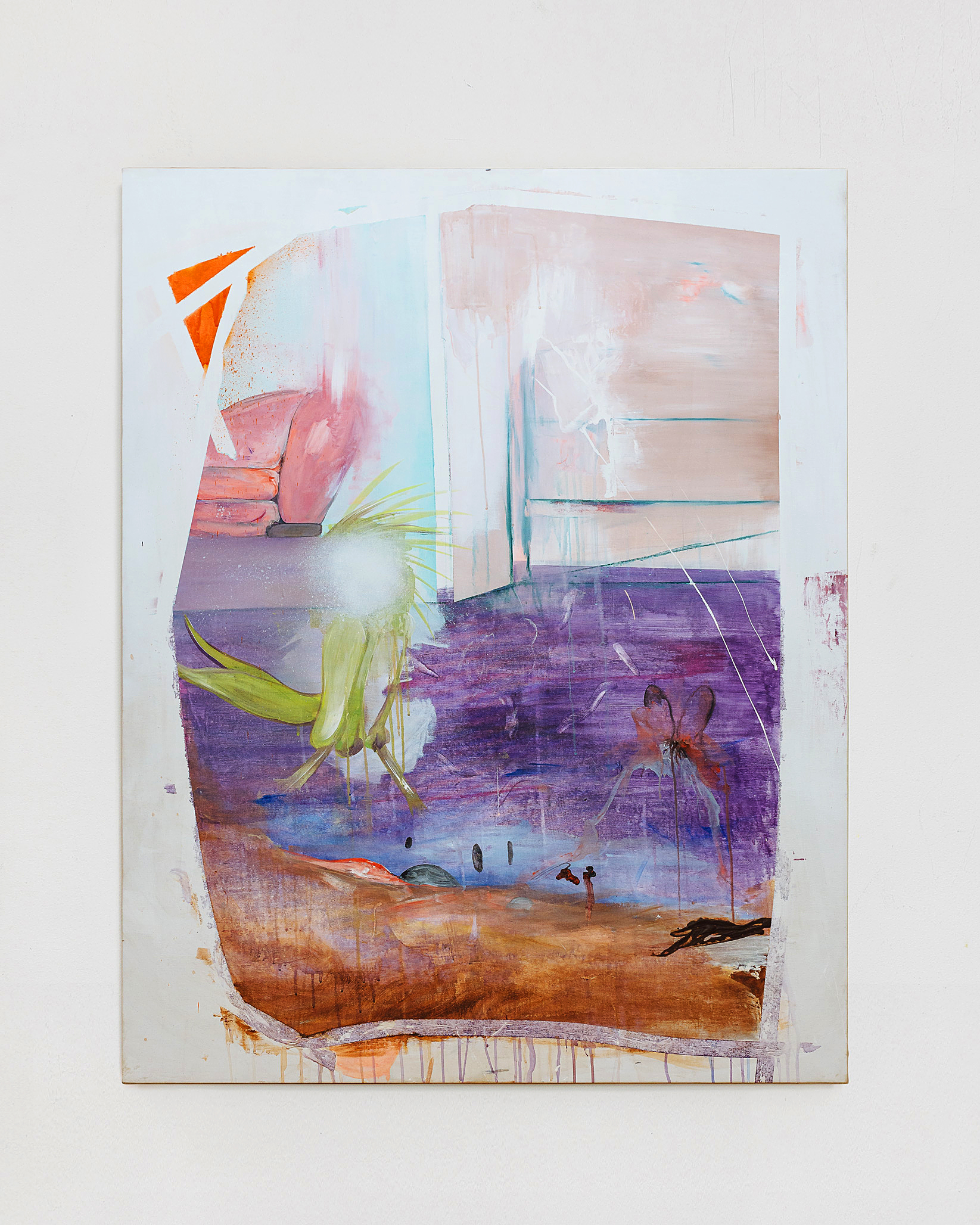
A Carnival to my ears, 2023, Acrylic and oil on linen, 130 x 100 cm
Nada Baraka (Egypt)
Nada Baraka makes paintings that maintain an endless, active state of flux, swaying between abstract and surreal with her evocative application and vivid colours. Baraka seeks to generate forms in new contexts as a means to challenge and deconstruct the obvious, and tease meaning out of absurdity.
Fluctuations of emotions triggered by various experiences build up to a narrative that eludes interpretation. The core of her work is this process that seeks to narrate an experience through expressionist brushwork and surrealist methodology. A central aspect in those narratives is the concept of eruption, appearing as distorted forms, body parts, colours or layers, all bathed in a fluidity that is punctuated with striking detail.
"As a female who believes in women empowerment and who struggles daily in a country that has one of the highest rates of harassment. It is important keep pushing and to pursue my practice loudly and proudly. To have a voice that will continue to evolve. This will happen by experimenting more frequently, trying new mediums and exploring new topics as well."

Délestage, 2019, Bronze patiné, Dimension variable, Unique
Beau Disundi (DRC)
The DRC happens to be one of the most resource-rich countries in the world, but the country has been plagued by conflict as paramilitary groups from Rwanda and Uganda take over towns in order to extract coltan and cobalt inexpensively. Funded by the West, these militants have created a situation characterised by extreme violence, with millions of internally displaced persons affected. Déléstage’s blue patina is a subtle nod to the terrible consequences of cobalt mining and our society’s tendency to extract from, verses to respect and nurture, the environment and her people.
Bearing the aforementioned in mind, Disundi’s Déléstage (Detour, in English) draws attention to the the most powerful hydrological dam Inga; Inga is able to provide electricity and energy to the rest of the African continent, yet many nearby towns often experience power cuts. The centrality of this project revolves around resource distribution and how electrical energy, which is vital for the existence and/or survival of people, is in fact a daily battle. The work also evaluates the perceived anarchy that has led to the proliferation of alternative modes of energy production such as; (a) generators for those who can afford it, (b) but also people who divert, therefore steal, electrical cables from electrical poles, or (c) the battery of an electric car, especially in rural areas. One ought to bear in mind that resource distribution is seldom in favour of previously marginalised groups, particularly where forced displacement has taken place, rendering them the most vulnerable. Thus, Disundi terms his figures as the ‘nameless’; the people most affected by political, economic, social and environmental changes, yet with no voice or power to change their situation.
Déléstage incorporates a carefully constructed ‘Nameless’ made from codfish cardboard. The impact of cod is hard to fathom, yet here it is at the heart of our universal. Numerous maritime expeditions, motivated by economic expansion, have left their mark on history. Discoveries, conquests, colonization, slavery - so many events shared by our peoples, with cod as a common denominator. Today, Disundi is developing a project that lays the foundations for his reflections by revisiting the birth and development of capitalism in our cultures through the history of cod. The artist’s exploration enables him to better understand the interrelationships between economics, history and cultural impact.

Earth Form_ Rust 2.0, 2022, Stoneware clay, 44 x 35 x 37cm
Nindya Bucktowar (Mauritius)
Often referred to as mud mountains, Earthforms are an exploration of monumental moments in nature. Textures and forms are extracted from topographical earth formations, to bring the viewer to a playful sense of scale and a re-examination of one’s relationship with the spaces that we occupy.
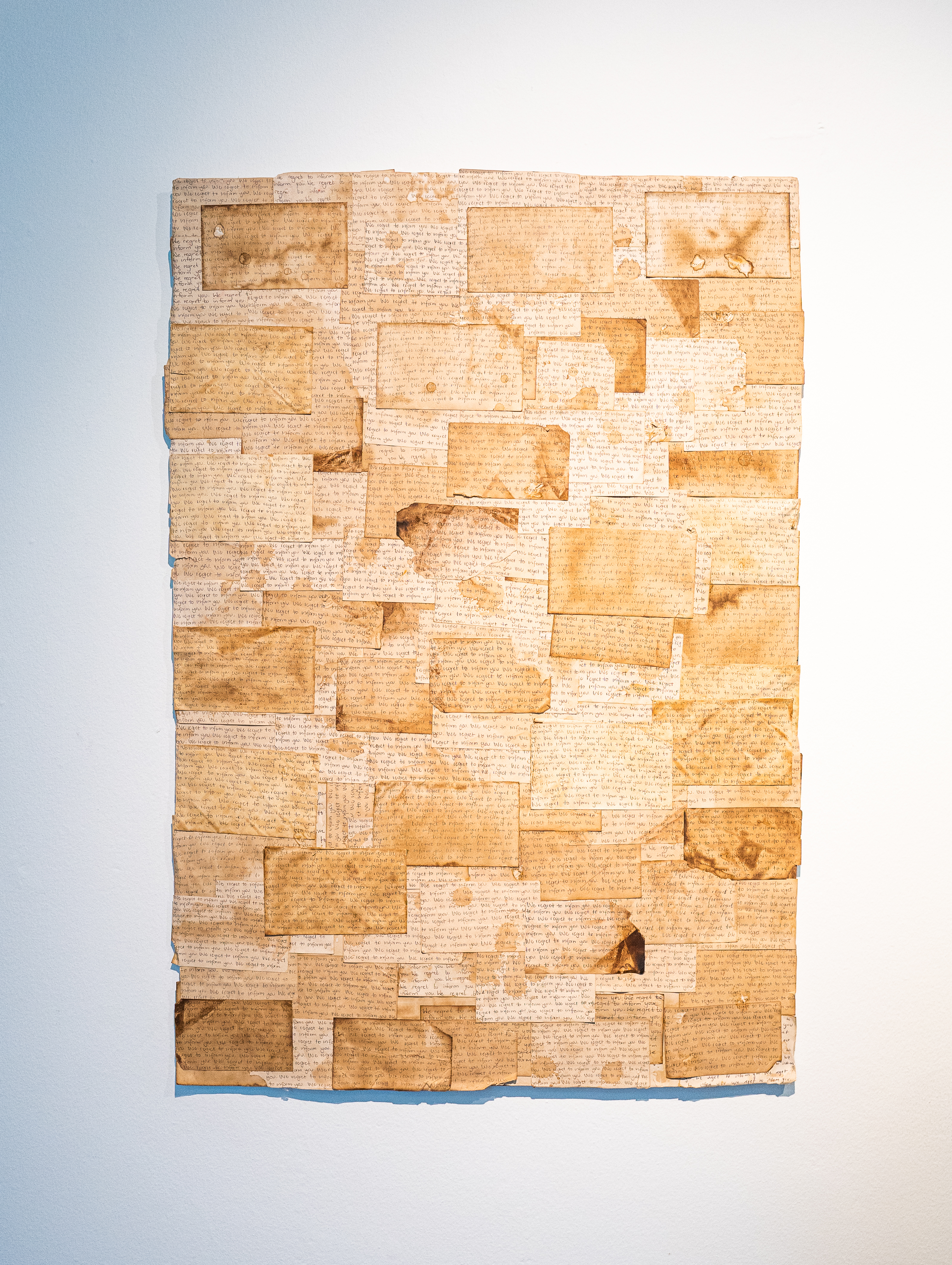
We regret to inform you III, 2023, Hand-written envelopes, 95 x 67 cm
Wezile Harmans (South Africa)
Developed from his original exhibition at the Bag Factory in 2022, DO NOT TRUST THE BORDERS focuses on the challenges of migration and its dehumanising impact on migrants. In a body of work that ranges from installation to video and mixed media works, Harmans explores the gatekeepers or boundaries that continue reinstating invisible othering by acknowledging only those who ‘belong’ and isolating others. Turning to batting material, bandages and paper, tea and coffee, Harman interrogates the migration policies that have resulted in the dehumanization of certain bodies through the colonial visa application processes.
Using his interdisciplinary approach as a tool for social change Harmans’ work confronts prejudices and advocates against social inequality, creating a platform for critical self-reflexivity within unwelcoming spaces. DO NOT TRUST THE BORDERS investigates the concept of displacement and dispossession. These very terms seem to be experiences of those who have been kept out due to physical and psychological borders which surround them. Harmans explores how the creation of a ‘border’ reproduces and strengthens the negative narratives that exist amongst people and their geographical borders.
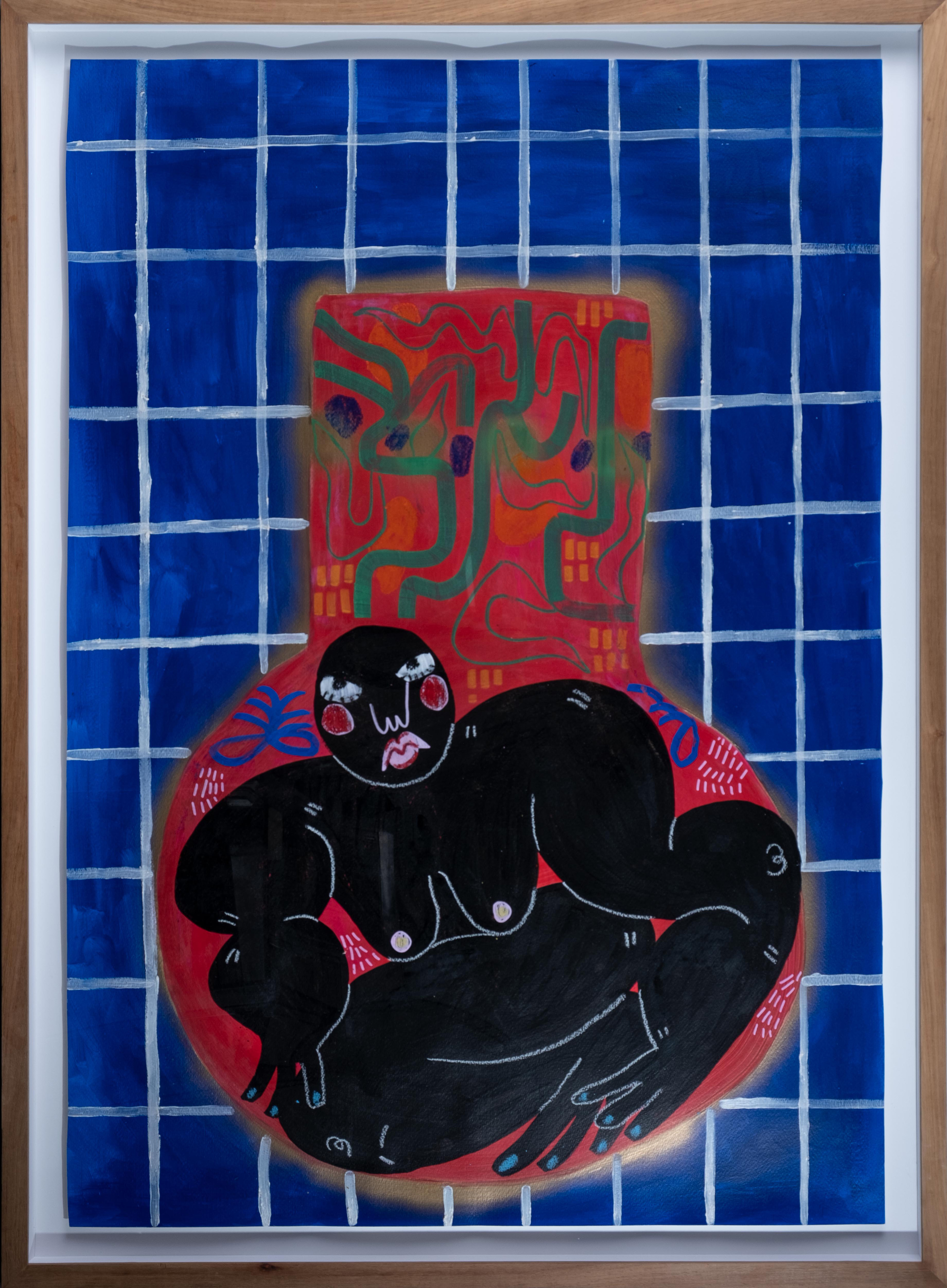
When you see a sign III, 2022, Mixed media on paper with Kiaat frame,142 x 111 cm
Boemo Diale (South Africa)
The power of prayer through colourful expressions; the idea of a cyclic loop through generations - history and human experiences are not linear, but rather circular, with events and circumstances echoing themselves over time. Boemo Diale captures the notion that certain patterns, behaviours, or characteristics tend to repeat or resurface across different generations.
Each image acts as self reflection with consideration to the past, present and future, dreams and manifestations. Through vibrant hues and compositions, Diale aims to create visual narratives that evoke a sense of spirituality and transcendence by meddling in bizarre imagery, San rock art, African symbols of devotion and intuitive mark-making. The attention given to each visual element becomes a form of devotion - an act of reverence that captures the essence of prayer.
Serving as a vessel to carry these prayers and meanings, the utilitarian pot is a motif rendered in warm and cool tones, combining metaphors to represent the interplay between introspection and connection. Colours are layered and intertwined, creating depth and movement, symbolising the fluidity of prayer as it weaves through our lives.
Through these variations of metaphor in practice, Diale considers if it is possible to break the curses that play on a loop across generations. She suggests that prayer transcends religious boundaries - re-contextualising it as a way to navigate through universal longing for meaning. By using her practice as a mode of mimicking, Diale has created a form of personal devotion; an expression of vulnerability, hope, and gratitude and protection, bordered by prayer.
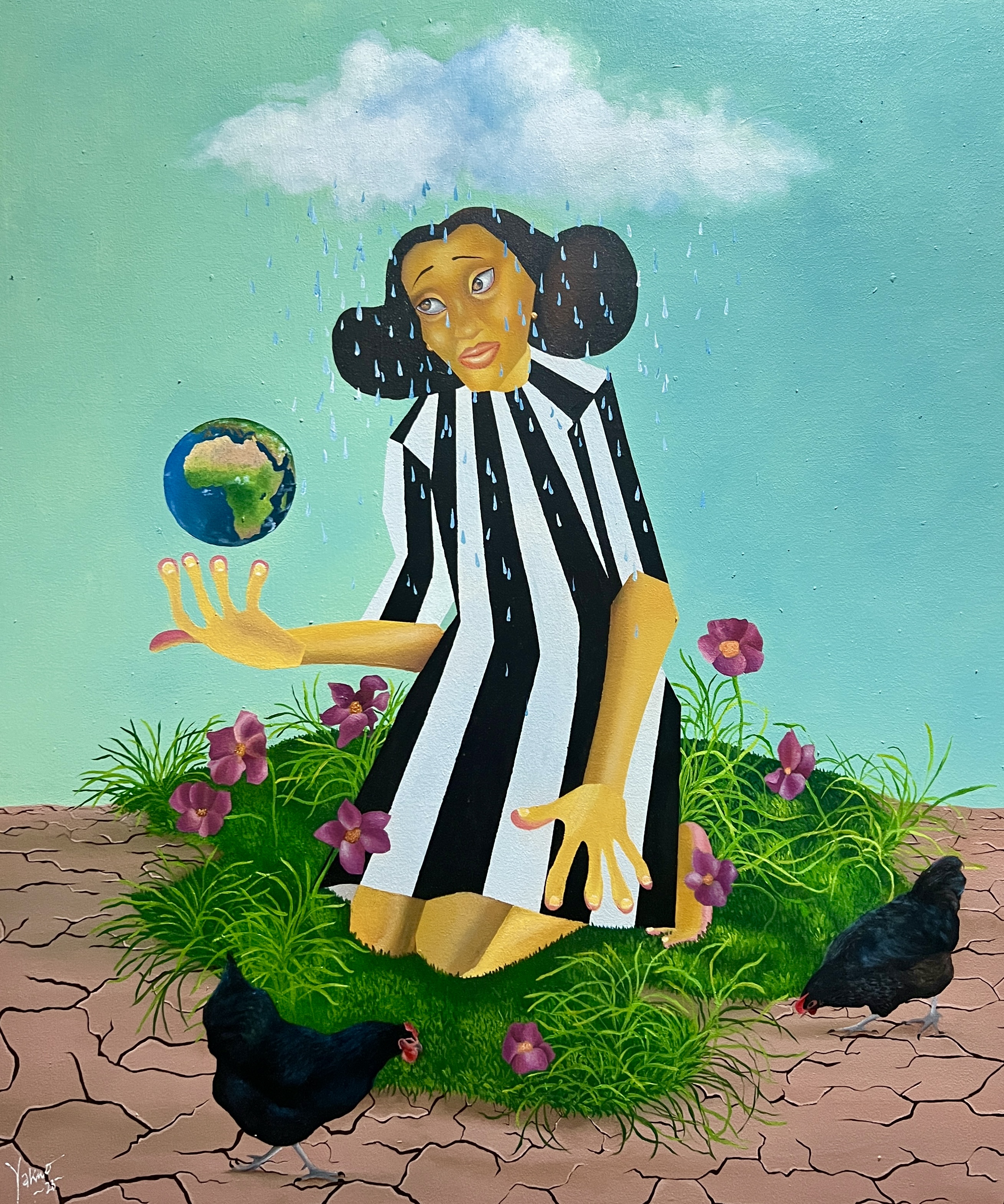
What is feminism?, 2023, Acrylic paint on canvas, 94 x 110 cm
Ene Yakno Abasi Jessicah (Nigeria)
Ene Yakno-Abasi Jessicah (b. 1998) is a surrealist painter born and based in vibrant Lagos, Nigeria. Yakno's artistic exploration is driven by a profound appreciation for the expressive qualities of the medium. Raised in a close-knit family primarily composed of women, her art is a reflection of the depth of sororal bonds, and how they manifest from shared memories and experiences.
Yakno takes advantage of the expressive nature of her artistic practice to create work which pushes forward intersectional feminism, with a particular emphasis on the empowerment and representation of women in third world countries. Utilising mixed media and a vibrant colour palette, she skillfully crafts stylized characters, seamlessly blending two-dimensional elements with the richness, proximity, gestures, and values of three-dimensional imagery. This approach adds layers of texture and depth, enhancing the expressiveness and perceptual experience of her paintings for all viewers. Yakno has taken part in several group shows in Nigeria, while she has also found her place in private and corporate collections, both in her home country and abroad.
Further Reading In Articles
African Artist Directory































